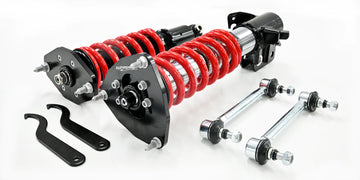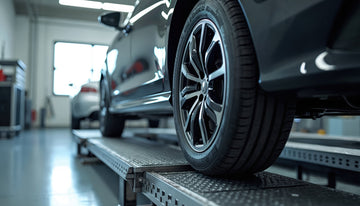Welcome to the exhilarating realm of high-performance aftermarket suspension systems! If you're a motorsport enthusiast seeking to enhance your vehicle's handling capabilities or a passionate car lover looking to elevate your driving experience, aftermarket suspension systems are the gateway to a world of precision, control, and performance.
These remarkable components go beyond the limitations of factory-installed suspensions, offering the opportunity to tailor your vehicle's dynamics to match your unique driving style and preferences. However, to fully unleash the potential of these cutting-edge suspension systems, comprehensive testing and meticulous maintenance are of utmost importance.
What are the parts of an aftermarket suspension system?
An aftermarket suspension system consists of several key components, each serving a specific function to enhance the performance and handling characteristics of your vehicle. Let's explore the essential parts and their roles:
Springs
Springs are fundamental components of the suspension system, responsible for supporting the vehicle's weight and absorbing road irregularities. They come in various types, including coil springs and leaf springs. Aftermarket performance springs are often stiffer than stock springs, providing improved handling, reduced body roll, and enhanced responsiveness.
Dampers/shock absorbers
Dampers, commonly known as shock absorbers, work in conjunction with springs to control the movement of the suspension. They regulate the oscillation and rebound of the springs, ensuring that the tires maintain consistent contact with the road. High-performance aftermarket dampers offer adjustable settings, allowing you to fine-tune the suspension's compression and rebound characteristics for different driving conditions.
Sway bars/stabiliser bars
Sway bars, also known as stabiliser bars, are designed to reduce body roll during cornering. They connect the suspension components on both sides of the vehicle, transferring load between the wheels. Upgraded sway bars provide increased stiffness, minimising body roll and improving stability while maintaining traction and control.
Control arms/wishbones
Control arms, or wishbones, connect the suspension system to the chassis. They play a crucial role in controlling the motion and alignment of the wheels. Aftermarket control arms are often lighter and stronger than stock components, offering improved rigidity and reducing unsprung weight for enhanced handling and responsiveness.
Bushings
Bushings are rubber or polyurethane components that act as a cushion between various suspension parts, reducing vibration and absorbing road noise. Upgraded bushings can improve suspension response by minimising deflection and providing more precise feedback from the road.
Alignment components
Alignment components, such as adjustable camber plates, toe arms, and caster kits, allow fine adjustments to the wheel angles. Proper alignment ensures optimal tire contact, even wear, and predictable handling characteristics. Aftermarket alignment components offer increased adjustability, enabling enthusiasts to fine-tune their suspension setup for specific driving preferences or track conditions.
Why is it important to test and maintain high-performance aftermarket suspension systems?
Dynamic testing assesses how well the suspension system responds to changes in road surfaces, cornering forces, braking forces, and acceleration forces. It helps determine if the system provides adequate stability, control, and comfort for the vehicle occupants.
Durability testing evaluates how well the suspension system withstands prolonged use over time. This includes assessing its resistance to fatigue failure or premature wear due to constant vibrations or impacts on rough roads.
Testing these suspension systems is essential to ensure their reliability, safety, and optimal functionality. Maintaining and testing high-performance aftermarket suspension systems are of paramount importance for several reasons, including;
Performance optimisation
Testing allows you to fine-tune your suspension system to achieve optimal performance. By understanding how different adjustments impact your vehicle's handling, responsiveness, and stability, you can tailor the setup to match your driving style and preferences. Testing enables you to uncover the perfect balance between comfort and performance, ensuring that your vehicle handles precisely the way you desire.
Safety enhancement
Suspension systems play a critical role in maintaining vehicle stability and control. Rigorous testing helps identify potential weaknesses or limitations in the system, allowing you to address them proactively. By ensuring that your suspension is in peak condition, you can enhance safety on the road, especially during high-speed manoeuvres, abrupt braking, or evasive manoeuvres.
Customisation and personalisation
Aftermarket suspension systems offer a wide range of adjustability and customization options. Through testing, you can explore various settings and configurations to find the perfect balance that suits your specific needs. Whether you prefer a stiff and responsive setup for track use or a more comfortable ride for daily commuting, testing enables you to personalise your suspension system for the ultimate driving experience.
Performance consistency
High-performance suspension systems are subjected to significant stresses and forces during spirited driving or competitive events. Regular maintenance helps identify and rectify any wear, damage, or degradation that may occur over time. By addressing these issues promptly, you can maintain consistent performance and prevent further damage to other suspension components. Regular maintenance not only ensures optimal performance but also prevents costly repairs that may arise from neglect or lack of attention.
Longevity and cost effectiveness
Proper maintenance practices, such as inspections, lubrication, and component replacements, help prolong the lifespan of your suspension system. By detecting and resolving issues early on, you can avoid costly repairs or premature replacements. Maintaining your suspension system ensures that it operates efficiently, reducing the risk of additional wear and extending its overall durability.
How can I inspect my aftermarket suspension system?
Inspecting your aftermarket suspension system involves the following steps to ensure its optimal performance and safety;
- Park on a level surface: Find a flat and level area to park your vehicle. Engage the parking brake and turn off the engine.
- Visual inspection: Begin by visually inspecting the suspension components. Look for any signs of damage, such as leaks, cracks, or dents. Check for loose or missing bolts, excessive rust, or any unusual wear patterns on the suspension parts.
- Tire inspection: Examine the tires for any uneven wear patterns, such as cupping or feathering. Uneven tire wear can indicate issues with the suspension, such as misalignment or worn components. Also, check the tire pressure to ensure it is within the manufacturer's recommended range.
- Bounce test: Stand near each corner of the vehicle and push down firmly on the body. Release and observe how the vehicle reacts. It should rebound once or twice and then settle. Excessive bouncing or a lack of rebound may indicate worn shocks or struts.
- Wheel play inspection: Grab each wheel at the 9 o'clock and 3 o'clock positions and attempt to rock it back and forth. There should be minimal to no play. Excessive wheel play may indicate worn ball joints or tie rod ends.
- Steering response: Start the engine and turn the steering wheel from lock to lock. Listen for any unusual noises, such as grinding or clunking sounds. Smooth and responsive steering without noise suggests the steering components are in good condition.
- Test drive: Take your vehicle for a test drive on various road surfaces. Pay attention to any abnormal noises, vibrations, or pulling to one side. These issues could indicate suspension problems or misalignment.
Inspecting your suspension system on your own can provide valuable insights into its condition, but it's important to note that suspension systems are complex and require specialised knowledge for a thorough assessment. Experts stress the need for proper alignment after installing an aftermarket suspension system. Improper alignment can lead to uneven tire wear, reduced handling capabilities, and potential safety issues.
While you can perform basic visual checks, tire inspections, and bounce tests, it is highly recommended to have your suspension inspected by an experienced professional. They have the expertise, tools, and diagnostic capabilities to identify potential issues that may not be apparent during a DIY inspection, ensuring your suspension system receives proper attention and maintenance for optimal performance and safety.
What goes into testing aftermarket suspension systems?
Testing aftermarket suspension systems in cars involves a range of methods to assess their performance, durability, and overall effectiveness. Here are some key testing methods commonly employed:
Swingarm deformation and fatigue test measurements
To evaluate the strength and durability of suspension swingarms, deformation and fatigue tests are conducted. These tests involve subjecting the swingarm to various loads, simulating real-world conditions, and measuring the resulting deformation. By analysing the deformation and evaluating fatigue limits, manufacturers can ensure that the swingarm can withstand the stresses encountered during normal driving conditions.
Vehicle axle durability and fatigue tests
Axle durability and fatigue tests assess the strength and endurance of aftermarket suspension system axles. These tests involve applying cyclic loads to the axles to simulate years of use and measure their resistance to fatigue failure. By subjecting the axles to repeated stresses, manufacturers can identify any potential weaknesses or areas for improvement.
Front suspension frame durability and fatigue tests
Front suspension frame durability and fatigue tests are conducted to evaluate the strength and longevity of the suspension frame. The frame is subjected to various forces and movements to simulate real-world conditions, ensuring it can withstand the stresses encountered during normal driving. These tests help manufacturers identify any weak points and make design modifications to enhance durability and performance.
Strain gauge measurements
Strain gauge measurements involve attaching strain gauges to suspension components to measure the deformation and strain they experience under different loads. These gauges provide valuable data on how the suspension system responds to forces, allowing manufacturers to fine-tune designs for optimal performance and reliability. Strain gauge measurements help identify areas of high stress concentration, enabling engineers to make necessary adjustments to enhance durability.
Vehicle mileage accumulation testing
Vehicle mileage accumulation testing involves driving vehicles equipped with aftermarket suspension systems for extended periods to assess their long-term performance and reliability. By accumulating mileage in various driving conditions, manufacturers can evaluate how the suspension system holds up over time, identifying any potential issues or areas for improvement. This testing method helps ensure that the suspension system maintains its performance characteristics and durability over the expected lifespan.
Subjective assessments of vehicle behaviour and durability
In addition to quantitative measurements and tests, subjective assessments play a crucial role in evaluating aftermarket suspension systems. Skilled test drivers and engineers subjectively assess the vehicle's behaviour, handling, and overall durability during test drives. Their observations and feedback provide valuable insights into how the suspension system performs in real-world scenarios and help refine the system's design and performance.
What are the signs of wear and/or damage for an aftermarket suspension system?
Signs of wear and damage in an aftermarket suspension system can manifest in various ways. Here are some common signs to watch out for:
- Uneven or excessive tire wear, such as cupping or feathering.
- Excessive bouncing or increased body roll during driving.
- Unusual noises like clunking, knocking, or squeaking sounds.
- Vibrations felt through the steering wheel or vehicle's body.
- Leakage of fluid from shocks or struts.
- Altered ride height, appearing sagging or higher than usual.
- Harsh or rough ride quality.
- Changes in vehicle handling, responsiveness, or stability.
- Loose or worn-out suspension components, visible movement or play.
- Increased steering effort or instability.
- Noticeable reduction in overall comfort during driving.
- Lack of suspension damping or excessive rebound.
If you notice any of these signs, it is important to have your suspension system inspected by a qualified professional. Neglecting suspension system testing or maintenance can lead to decreased performance capabilities, increased risk of accidents due to compromised handling abilities, premature component failure,and costly repairs/replacements in the long run.





